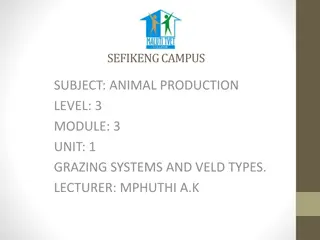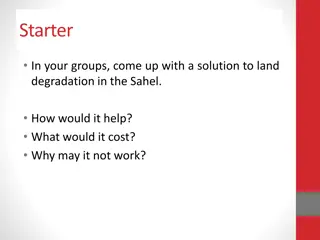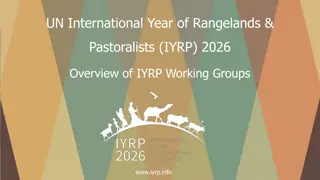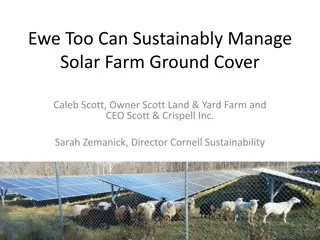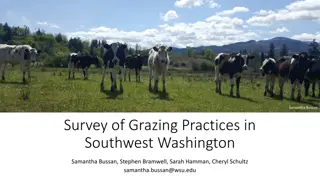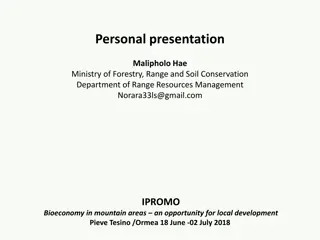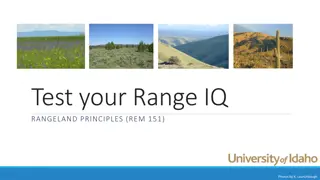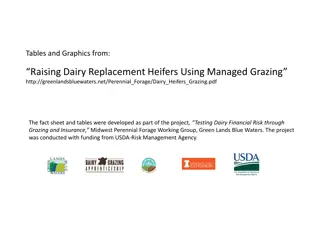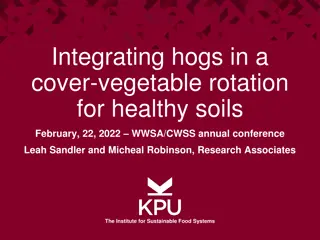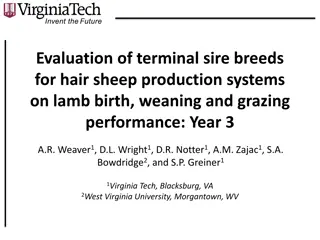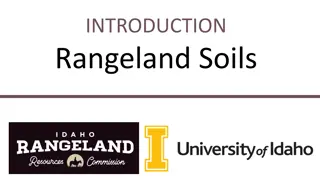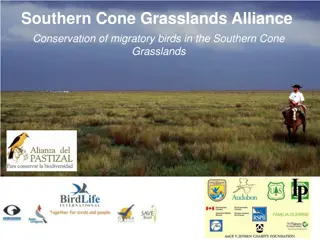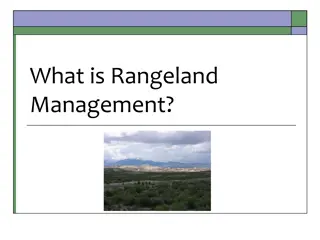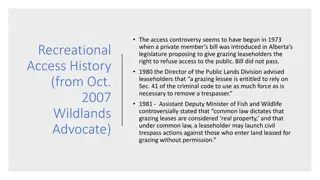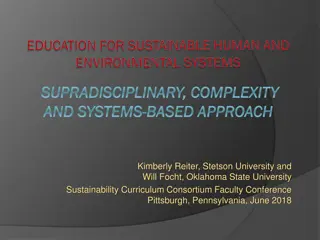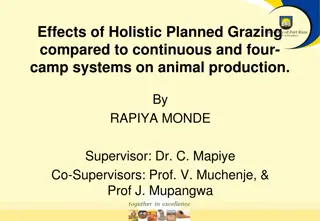Grazing Methods and Systems for Sustainable Rangeland Management
Grazing methods and systems play a key role in maintaining and enhancing rangeland ecosystems. They can achieve various goals such as vegetation improvement, uniform use of grazing units, stabilizing forage supply, and enhancing wildlife habitat. Terms like grazing system, grazing period, deferment, and rest are essential in understanding effective grazing practices. Basic grazing systems like continuous grazing and deferred rotation offer unique benefits and considerations for sustainable land management.
Download Presentation

Please find below an Image/Link to download the presentation.
The content on the website is provided AS IS for your information and personal use only. It may not be sold, licensed, or shared on other websites without obtaining consent from the author.If you encounter any issues during the download, it is possible that the publisher has removed the file from their server.
You are allowed to download the files provided on this website for personal or commercial use, subject to the condition that they are used lawfully. All files are the property of their respective owners.
The content on the website is provided AS IS for your information and personal use only. It may not be sold, licensed, or shared on other websites without obtaining consent from the author.
E N D
Presentation Transcript
J. Peterson J. Hinson C. White K. Launchbaugh Grazing Methods or Systems RANGELAND PRINCIPLES (REM 151)
What can grazing methods accomplish? Maintain or accelerate vegetation improvement. Improve uniform use of all grazing units. Stabilize the forage supply throughout the grazing season. Enhance forage quality for livestock and wildlife. Improve function of ecological processes. Protect watersheds. Enhance wildlife habitat. J. Hinson From National Range and Pasture Handbook
Terms of Grazing Methods Grazing System = a planned effort to leave some areas unused for at least part of the year. Grazing Period = season and number of days when pasture is grazed. Deferment = a period of non-grazing until key forage species set seeds. Rest = a period of non-grazing for a full year.
Deferment vs Rest Rest Deferment Potential Damage Green-up Growth Initiation Flowering/Seed Set Dormancy
Basic Grazing Systems Continuous Grazing: Grazing the whole area for the whole grazing season. Pros/Cons? + Simple/low input + Animals get maximum choice and have high animal performance. Ranch Headquarters Plants and areas that livestock prefer can be excessively used and become degraded. Map Legend Water tanks Steep rocky range site Salt Perennial Stream
Basic Grazing Systems Deferred Rotation: Do not graze at least one pasture until after it has set seed (defer). In subsequent years, change the pasture deferred so the deferment is rotated among all the pastures over years. North River Pasture Upland Pasture Deferred Rotation - 1 Herd|3 Pasture Months of the Year M J Grazed Year 1 North South Upland A J A S O Grazed Grazed Deferred Year 2 North South Upland A M J J A S O Deferred Grazed South River Pasture Grazed Grazed Year 3 North South Upland A M J J A S O Grazed Grazed Deferred Grazed
Basic Grazing Systems Deferred Rotation: Do not graze at least one pasture until after it has set seed (defer). In subsequent years, change the pasture deferred so the deferment is rotated among all the pastures over years. Pros/Cons? + Rangeland condition can improve because pastures are occasionally not grazed when they are most sensitive to grazing. Can reduce animal performance a little because animal opportunity to choose among plants and places is restricted. Requires more fencing and management.
Basic Grazing Systems Rest Rotation: Do not graze at least one pasture for a whole year (rest). In subsequent years, change the pasture rested so rest is rotated among all the pastures. Rest Rotation - 1 Herd|3 Pasture Months of the Year M J Grazed Hill Pasture Spring Pasture Year 1 Spring Hill Creek A J A S O N Grazed No grazing Year 2 Spring Hill Creek A M J J A S O N Grazed No grazing Grazed Creek Pasture Year 3 Spring Hill Creek A M J J A S O N No grazing Grazed Grazed
Basic Grazing Systems Rest Rotation: Do not graze at least one pasture for a whole year (rest). In subsequent years, change the pasture rested so rest is rotated among all the pastures. Pros/Cons? + Rangeland condition can improve because pastures are allowed to be rested and set seed every few years. Can reduce animal performance because stocking rate is increased on grazed pastures (since at least 1 pasture is not grazed) and animals are always moved into pastures that were not recently grazed and have dormant stems mixed with green growth.
Basic Grazing Systems Short-Duration: Each pasture in the unit is grazed for a short time and animals are rotated through all available pastures so that each pasture is grazed at least two times per year. Pasture A Pasture B Pasture C Pasture H Water tanks Well with water line Pasture G Pasture D Pasture F Pasture E
Basic Grazing Systems Short-Duration: Each pasture in the unit is grazed for a short time and animals are rotated through all available pastures so that each pasture is grazed at least two times per year. Pros/Cons? + Stocking rate often higher because animals eat all plants. + Forage quality can be higher because animals are always eating green fresh regrowth. + Range condition sometimes improves because all plants are grazed not just the plants that animals favor. Animal performance is usually low on this system because animals have to eat all plants available can t only eat their favorites. Rangeland condition can be decreased because plants never get a rest or deferment.
Basic Grazing Systems Seasonal-Suitability: Moving livestock to different areas of range depending on growth patterns of different vegetation types (i.e., following the green). Summer Range Spring/Fall Winter Range Seasonal Suitability - 1 Herd|Multiple Pastures/Grazing Areas Months of the Year Pastures and Grazing Areas Winter Range Spring/Fall Summer (Mtn) J F M A M J J A S O N D Graze Graze Graze Graze Graze
Basic Grazing Systems Seasonal-Suitability: Moving livestock to different areas of range depending on growth patterns of different vegetation types (i.e., following the green). Pros/Cons? + Animals have green forage most of year = high growth and performance. + Plants mostly grazed early in season before seedset. High management/herding input. Summer range many not get deferment. Summer Range Spring/Fall Winter Range
Decisional or Management Intensive One Herd: Multiple Pastures Make decisions based on management considerations such as: Available forage Available water Cover for calving and lambing To facilitate other practices such as haying or prescribed fire These systems are probably the most common in the world and their success depends on the experience and decisions of the manager.
Decisional or Management Intensive Best-pasture system: Move livestock to pasture that looks the best in terms of forage availability. Designed for arid areas where rain may improve forage on one part of a ranch but not affect another part. Complementary system: Designed in the central plains where animals rely on: Cultivated or improved pastures for part of the year and then are moved to native range. Seasonal-suitability: Movement of livestock to different areas of range depending on: the growth patterns of different vegetation types.
Which grazing system is best? There is no silver bullet system that will work everywhere. There are thousands of variations on a theme All systems need to be flexible to manage unexpected disturbance such as fire or weed invasions. Blm.gov
Which grazing system is best? There is no silver bullet system that will work everywhere. Success of grazing systems depends on: Type of forage Terrain Weather patterns Skill of manager Blm.gov No matter the system stocking rate, species of grazing animal, and distribution patterns are important in determining how the systems affect vegetation communities.
What can grazing systems accomplish? A view from Australia https://www.youtube.com/watch?v=Jygi7ftAe8Q
Quiz/Exam Review 1. Define grazing system, grazing period, deferment, rest, and stock density. 2. Describe the 5 basic grazing systems (continuous, deferred rotation, rest rotation, short duration, seasonal-suitability) and the pros/cons for each. 3. Describe best-pasture system and complementary system. 4. Which grazing system is best? 5. What can grazing systems accomplish? 6. What can grazing systems not accomplish?





